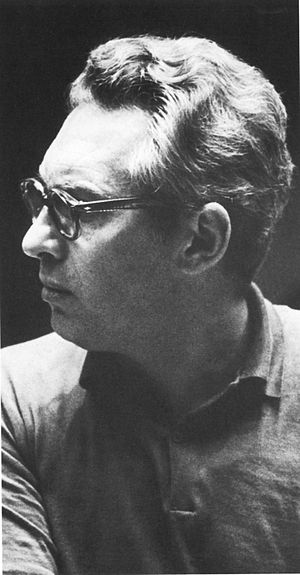Playlist of Géza Anda performing works of Rachmaninoff, Beethoven, Chopin and Tchaikovsky.
| Géza Anda (um 1965) (Photo credit: Wikipedia) |
1-4. Geza Anda plays Rachmaninoff Piano Concerto No.2
Conductor: Alceo Galiera, Pilharmonia Orchestra
5. Geza Anda plays Rachmaninoff Plerude in g-moll, op.23 no5
6. Geza Anda plays Rachmaninoff Plerude in g-moll, op.32 no5
7-10. Géza Anda plays Beethoven Diabelli Variations op.120
11-12. Géza Anda plays Beethoven Sonata No.7, op.10 no.3. 1955 live recording; composed in 1798, dedicated to Countess Anne Margarete von Browne.
13. Géza Anda plays Chopin 12 Etudes Op 25 No 1, 2, 3, 4
1.in A flat major. Allegro sostenuto
2.in F minor.Presto
3.in F mojor.Allegro
4.in A minor.Agitato
Live in Ascona,16.09.1965
14. Géza Anda plays Chopin 12 Etudes Op 25 No 5, 6
5.in E minor. Vivace
6.in G sharp minor.Allegro
Live in Ascona,16.09.1965
15. Géza Anda plays Chopin 12 Etudes Op 25 No 7, 8, 9
7.in C shrap minor.Lento
8.in D flat major.Vivace
9.in G flat major.Allegro assai
Live in Ascona,16.09.1965
16. Géza Anda plays Chopin 12 Etudes Op 25 No 10, 11, 12
10.in B minor
11.in A minor
12.in C minor
Live in Ascona,16.09.1965
17. Géza Anda plays Chopin Polonaise No.6 in A-flat major, op.53, "Heroique". Composed in 1842.
18-21. Géza Anda plays Tchaikovsky Piano Concerto No.1
Alceo Galliera, Philharmonia Orchestra
Géza Anda (1921 - 1976)
Hungarian pianist, born in Budapest. He studied with some of the renowned teachers of the 20th century such as Imre Stefaniai and Imre Keeri-Szanto, and became a pupil of Ernst von Dohnányi and Zoltán Kodály at the Franz Liszt Academy in Budapest.
Anda made his debut in 1939 in Budapest under Willem Mengelberg playing Brahms B flat major concerto, which would become his signature. In 1940 he won the Liszt Prize, and in the next year, he made an international name for himself with his performance of Brahms' Piano Concerto No. 2. In 1941, he also made his debut with the Berlin Philharmonic under Wilhelm Furtwängler, who dubbed him "troubadour of the piano." He remained in Berlin during the first years of World War II, but in 1942 he fled to Switzerland, where he encountered the great pianist and teacher Edwin Fischer. Fischer was a proponent of performing the Mozart piano concertos while conducting from the keyboard and Anda would later adopt this practice, adding bench-led performances of all the concertos (even the early ones) to his repertoire. He was among the first to explore the whole range of Mozart's concertos, at a time when only the "greatest hits" were heard in concert halls; his outstanding 1960's recordings of the complete cycle with the Camerata Academica of the Salzburg Mozarteum remain a milestone in the history of recorded music.
Géza Anda's style was noteworthy for its transparency of texture and its singing qualities, which led Wilhelm Furtwängler to dub him a "troubadour" of the piano. His flawless technique allowed him to invest his performances with considerable individuality: his readings of Schumann, for instance, were breathtakingly multidimensional, full of asides and highly appropriate introspective commentary conveyed from within Schumann's notes. He was especially influenced by his artistic partnership with the great Romanian pianist Clara Haskil, with whom he played two-piano repertoire from 1953 to 1958. Her moral commitment to conveying music's essence deepened Anda's own musical insight; his subsequent performances reflected a new harnessing of his strong musical personality to the service of the music's meaning.
Although his repertoire was wide and ranged across core Classical-Romantic territory, it is likely that Géza Anda will be most remembered for his interpretations of the music of his countryman Béla Bartók, whose three piano concertos he recorded in 1959 and 1960. These performances are masterpieces of technical ease and artistic mastery, and remain available in commercial release. A few months before the end of his too-brief life, Anda went into the studio and left a final testament of waltzes by Chopin, interpreted in an astonishing otherworldly manner. He allows the rhythmic impulse of Chopin's triple-time to hover almost motionlessly, as if contemplated from a distant and ethereal height.
He was honored in 1965 by being named a Chevalier of the Ordre des Arts et des Lettres, and he also become an honorary member of the Royal Academy of Music in 1970.
He is considered to be one of the greatest pianists of the 20th century. A celebrated interpreter of classical and romantic repertoire, particularly noted for his performances and recordings of Mozart, he was also a tremendous interpreter of Beethoven, Schumann, Brahms and Bartók. In his heyday he was regarded as an amazing artist, possessed of a beautiful, natural and flawless technique that gave his concerts a unique quality. But since his death in 1976 at the age of fifty-five, his high reputation has faded somewhat from view.











